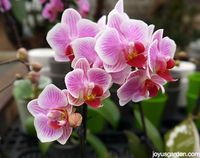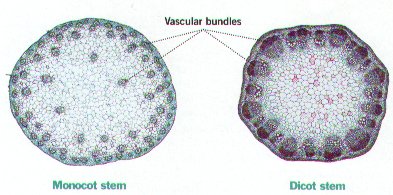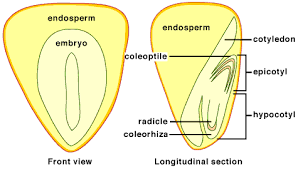Monocots: Difference between revisions
m The LinkTitles extension automatically added links to existing pages (https://github.com/bovender/LinkTitles). |
|||
| (3 intermediate revisions by 3 users not shown) | |||
| Line 3: | Line 3: | ||
[[File:orchid.jpg|left|200px|[16]|]] | [[File:orchid.jpg|left|200px|[16]|]] | ||
Monocots make up one of the largest groups of [[wikipedia:angiosperms|angiosperms]], or flowering plants, comprising a total of | Monocots make up one of the largest groups of [[wikipedia:angiosperms|angiosperms]], or flowering plants, comprising a total of 25 percent of all [[angiosperms]] [4]. The term monocot stems from most members of this group having one seed leaf, known as a [[wikipedia:cotyledon|cotyledon]]. There are nearly 60,000 different species of monocots and together they form a monophyletic group [2]. Well-known monocot families include Orchidaceae (orchids), the largest known plant family, Iridaceae (irises), and Arecaceae (palms) [13]. Monocots are of great economic and cultural importance around the world [13]. | ||
[[File:monodistems.jpg|border|frame|The scattered vascular structure of a monocot pattern (left) compared to the ring-shaped vascular structure of eudicots (right) [17].]] | [[File:monodistems.jpg|border|frame|The scattered vascular structure of a monocot pattern (left) compared to the ring-shaped vascular structure of [[wikipedia:eudicots|eudicots]] (right) [17].]] | ||
| Line 11: | Line 11: | ||
=Physical Structure= | =Physical Structure= | ||
The identifying feature of a monocot is a trimerious-pentacyclic flower design | The identifying feature of a monocot is referred to as a trimerious-pentacyclic flower design; this design consists of six tepals in two whorls, six stamens in two whorls, and three carpels. These features are virtually absent from earlier more basal angiosperms [8]. There are many defining features of a monocot, including: Floral parts in threes [9], leaves with veins that are arranged parallel to one another and do not join other veins, and primary vascular bundles containing both [[wikipedia:phloem|phloem]] and [[wikipedia:xylem|xylem]] in a scattered arrangement, known as an atactostele. There is no differentiation between cortical and stellar regions in monocots. This is another way in which monocots differ from eudicots, which have a ring like vascular bundle shape with distinct phloem and xylem, differentiated by the cortex and stele [15]. Root systems in monocots are characterized by a radical, which aborts at an early stage. Since the first root that emerges dies, a central taproot forms and roots grow adventitiously [3] | ||
[[wikipedia:Adventitious roots|adventitious roots]] sprout from shoot tissues near the base of the monocot. [[Root hairs]] of monocots are short-lived but are regularly replaced by new hairs as long as the root continues to grow. Monocots also lack a cambium, which allows for growth in diameter with height [3]. Due to the lack of a cambium, there is a limit on how tall shoots can grow and many monocots tend to be herbaceous. However, some monocots are able to grow to great heights, lengths, and masses such as agaves, palms, and bamboos. | |||
[[File:monocot_seed.png|frame|border|left|Seed structure in monocots shown in a front view (left) and a longitudinal cross section (right) [18].]] | [[File:monocot_seed.png|frame|border|left|Seed structure in monocots shown in a front view (left) and a longitudinal cross section (right) [18].]] | ||
| Line 24: | Line 25: | ||
=DNA= | =DNA= | ||
Based on recent data, monocots have been identified to be a monophyletic group that diverged from other angiosperms over a million years BP, during the Cretaceous era [2]. Advances in molecular systematics have enabled eight major groups of monocot to be identified. Moving from the most basal, these groups include Acorus, Alismatales, and a polytomy of six remaining clades known as Japonolirion, Dioscoreales, Pandanales, Liliales, Asparagales, and a commelinoid clade with subclades, Arecaceae, Zinigiberales, and Poales [5]. While monocots were originally named due to having a single cotyledon, 18s rDNA evidence has shown that a stronger uniting factor among monocots is pollen grain type. Through the use of molecular systematics, it has been found that taxa with | Based on recent data, monocots have been identified to be a monophyletic group that diverged from other angiosperms over a million years BP, during the Cretaceous era [2]. Advances in molecular systematics have enabled eight major groups of monocot to be identified. Moving from the most basal, these groups include Acorus, Alismatales, and a polytomy of six remaining clades known as Japonolirion, Dioscoreales, Pandanales, Liliales, Asparagales, and a commelinoid clade with subclades, Arecaceae, Zinigiberales, and Poales [5]. While monocots were originally named due to having a single cotyledon, 18s rDNA evidence has shown that a stronger uniting factor among monocots is pollen grain type. Through the use of molecular systematics, it has been found that taxa with monoaperturate pollen form a grade at the base of the angiosperm tree [11]. Nearly all monocots have been identified to have monoaperturate pollen grains which distinguishes them from a large eudicot clade with taxa having primarily triaperturate pollen [10]. | ||
= | =Families= | ||
Monocots include several different families such as Alismatales, Lilioids, Orchidaceae, Arecaceae, and Poaceae [19]. Alismatales are marine angiosperms that experienced a reduction or loss of features due to adaptations to aquatic environments and have large floral [[diversity]]. Lilioids are petaloid, showy monocots that have many ornamental features, elliptical leaves without a petiole, and are used as nectaries by pollinators such as birds and [[insects]]. Orchidaceae is one of the largest angiosperm families with over 22,000 species. They are terrestrial saprophytes and epiphytes that are highly specialized pollinators and usually have strong ornamentals. Arecaceae are the palms that are the tallest of all the Monocots with the largest seeds found in simple fruits. The leaves are compound and spirally arranged at the top of the stem. Lastly, the Poaceae are the grasses which contain over 10,000 different species and make up 20% of vegetation and provide a strong economic role for humans (food, lawns, etc.). The grasses grow from the base of the blade, rather than the tips, and the flowers are arranged into spikelets. | Monocots include several different families such as Alismatales, Lilioids, Orchidaceae, Arecaceae, and Poaceae [19]. Alismatales are marine angiosperms that experienced a reduction or loss of features due to adaptations to aquatic environments and have large floral [[diversity]]. Lilioids are petaloid, showy monocots that have many ornamental features, elliptical leaves without a petiole, and are used as nectaries by pollinators such as birds and [[insects]]. Orchidaceae is one of the largest angiosperm families with over 22,000 species. They are terrestrial saprophytes and [[epiphytes]] that are highly specialized pollinators and usually have strong ornamentals. Arecaceae are the palms that are the tallest of all the Monocots with the largest seeds found in simple fruits. The leaves are compound and spirally arranged at the top of the stem. Lastly, the Poaceae are the grasses which contain over 10,000 different species and make up 20% of vegetation and provide a strong economic role for humans (food, lawns, etc.). The grasses grow from the base of the blade, rather than the tips, and the flowers are arranged into spikelets [20]. | ||
=Uses= | =Uses= | ||
Monocots are of great cultural and economic importance. [[wikipedia:Grasses|Grasses]] | Monocots are of great cultural and economic importance. [[wikipedia:Grasses|Grasses]] in particular are monocots which are of vital importance to both humans and [[wikipedia:animals|animals]] (Poaceae) [4]. Monocots are ubiquitous in the diet of humans. Grains such as rice, wheat, and barley are all monocots [1]. Fruits such as plantains, coconuts, pineapples, and dates also fall under the monocot clade. In addition to the monocot’s dietary use, some monocots are used medicinally. The genus Dioscorea is responsible for producing diosgenin, a steroid-like compound that aids in making progesterone for many contraceptives. Indigenous communities around the world rely on monocots for medicinal purposes [6,7,14]. Other monocots used by humans include the [[wikipedia:sedge|sedge]] family (Cyperaceae), palms, lilies, bromeliads, skunk cabbage, and philodendron [9]. | ||
=References= | =References= | ||
Latest revision as of 13:45, 1 May 2025
Monocots

Monocots make up one of the largest groups of angiosperms, or flowering plants, comprising a total of 25 percent of all angiosperms [4]. The term monocot stems from most members of this group having one seed leaf, known as a cotyledon. There are nearly 60,000 different species of monocots and together they form a monophyletic group [2]. Well-known monocot families include Orchidaceae (orchids), the largest known plant family, Iridaceae (irises), and Arecaceae (palms) [13]. Monocots are of great economic and cultural importance around the world [13].

Physical Structure
The identifying feature of a monocot is referred to as a trimerious-pentacyclic flower design; this design consists of six tepals in two whorls, six stamens in two whorls, and three carpels. These features are virtually absent from earlier more basal angiosperms [8]. There are many defining features of a monocot, including: Floral parts in threes [9], leaves with veins that are arranged parallel to one another and do not join other veins, and primary vascular bundles containing both phloem and xylem in a scattered arrangement, known as an atactostele. There is no differentiation between cortical and stellar regions in monocots. This is another way in which monocots differ from eudicots, which have a ring like vascular bundle shape with distinct phloem and xylem, differentiated by the cortex and stele [15]. Root systems in monocots are characterized by a radical, which aborts at an early stage. Since the first root that emerges dies, a central taproot forms and roots grow adventitiously [3] adventitious roots sprout from shoot tissues near the base of the monocot. Root hairs of monocots are short-lived but are regularly replaced by new hairs as long as the root continues to grow. Monocots also lack a cambium, which allows for growth in diameter with height [3]. Due to the lack of a cambium, there is a limit on how tall shoots can grow and many monocots tend to be herbaceous. However, some monocots are able to grow to great heights, lengths, and masses such as agaves, palms, and bamboos.

Reproductive Structures
A monocot seed is comprised of the plant embryo, cotyledon and endosperm. The embryo will consume the endosperm and the cotyledon will transfer the stored energy to the embryo [12]. As the embryo develops it sends a primary root out of the seed coating and into the soil. A primary leaf is then pushed up through the seed coating to the surface. This process differs from dicots in that a dicot’s primary roots will grow towards the soil surface initially.

DNA
Based on recent data, monocots have been identified to be a monophyletic group that diverged from other angiosperms over a million years BP, during the Cretaceous era [2]. Advances in molecular systematics have enabled eight major groups of monocot to be identified. Moving from the most basal, these groups include Acorus, Alismatales, and a polytomy of six remaining clades known as Japonolirion, Dioscoreales, Pandanales, Liliales, Asparagales, and a commelinoid clade with subclades, Arecaceae, Zinigiberales, and Poales [5]. While monocots were originally named due to having a single cotyledon, 18s rDNA evidence has shown that a stronger uniting factor among monocots is pollen grain type. Through the use of molecular systematics, it has been found that taxa with monoaperturate pollen form a grade at the base of the angiosperm tree [11]. Nearly all monocots have been identified to have monoaperturate pollen grains which distinguishes them from a large eudicot clade with taxa having primarily triaperturate pollen [10].
Families
Monocots include several different families such as Alismatales, Lilioids, Orchidaceae, Arecaceae, and Poaceae [19]. Alismatales are marine angiosperms that experienced a reduction or loss of features due to adaptations to aquatic environments and have large floral diversity. Lilioids are petaloid, showy monocots that have many ornamental features, elliptical leaves without a petiole, and are used as nectaries by pollinators such as birds and insects. Orchidaceae is one of the largest angiosperm families with over 22,000 species. They are terrestrial saprophytes and epiphytes that are highly specialized pollinators and usually have strong ornamentals. Arecaceae are the palms that are the tallest of all the Monocots with the largest seeds found in simple fruits. The leaves are compound and spirally arranged at the top of the stem. Lastly, the Poaceae are the grasses which contain over 10,000 different species and make up 20% of vegetation and provide a strong economic role for humans (food, lawns, etc.). The grasses grow from the base of the blade, rather than the tips, and the flowers are arranged into spikelets [20].
Uses
Monocots are of great cultural and economic importance. Grasses in particular are monocots which are of vital importance to both humans and animals (Poaceae) [4]. Monocots are ubiquitous in the diet of humans. Grains such as rice, wheat, and barley are all monocots [1]. Fruits such as plantains, coconuts, pineapples, and dates also fall under the monocot clade. In addition to the monocot’s dietary use, some monocots are used medicinally. The genus Dioscorea is responsible for producing diosgenin, a steroid-like compound that aids in making progesterone for many contraceptives. Indigenous communities around the world rely on monocots for medicinal purposes [6,7,14]. Other monocots used by humans include the sedge family (Cyperaceae), palms, lilies, bromeliads, skunk cabbage, and philodendron [9].
References
[1] Anderson CL, Janssen T. 2009. Monocots. In: Hedges SB, Kumar S, eds. Timetree of life. New York: Oxford University Press, 203–212.
[2] Bremer, K. (2000). Early Cretaceous Lineages of Monocot Flowering Plants. Proceedings of the National Academy of Sciences of the United States of America, 97(9), 4707–4711. https://doi.org/10.1073/pnas.080421597
[3] Chase, M. W. (2004). Monocot relationships: An overview. American Journal of Botany. https://doi.org/10.3732/ajb.91.10.1645
[4] Fay, M. F. (2013). Monocots. Botanical Journal of the Linnean Society, 172(1), 1–4. https://doi.org/10.1111/boj.12052
[5] Furness, C. A., & Rudall, P. J. (2004). Pollen aperture evolution - A crucial factor for eudicot success? Trends in Plant Science. https://doi.org/10.1016/j.tplants.2004.01.001
[6] Mahomoodally, M. F. (2013). Traditional medicines in Africa: An appraisal of ten potent African medicinal plants. Evidence-Based Complementary and Alternative Medicine. https://doi.org/10.1155/2013/617459
[7] Maroyi, A. (2013). Traditional use of medicinal plants in south-central Zimbabwe: Review and perspectives. Journal of Ethnobiology and Ethnomedicine. https://doi.org/10.1186/1746-4269-9-31
[8] Remizowa, M. V., Sokoloff, D. D., & Rudall, P. J. (2010). Evolutionary History of the Monocot Flower 1. Annals of the Missouri Botanical Garden, 97(4), 617–645. https://doi.org/10.3417/2009142
[9] Robinson, R. (2016). Monocots. In M. S. Hill (Ed.), Biology (2nd ed., Vol. 3, pp. 104-106). Farmington Hills, MI: Macmillan Reference USA. Retrieved from 128.205.114.91 http://link.galegroup.com.gate.lib.buffalo.edu/apps/doc/CX3629800285/SCIC?u=sunybuff_main&xid=028f8864
[10] Soltis, D. E., Bell, C. D., Kim, S., & Soltis, P. S. (2008). Origin and early evolution of angiosperms. Annals of the New York Academy of Sciences. https://doi.org/10.1196/annals.1438.005
[11] Soltis, D. E., Soltis, P. S., Chase, M. W., Mort, M. E., Albach, D. C., Zanis, M., … Farris, J. S. (2000). Angiosperm phylogeny inferred from 18S rDNA, rbcL, and atpB sequences. Botanical Journal of the Linnean Society, 133(4), 381–461. https://doi.org/10.1006/bojl.2000.0380
[12] Sreenivasulu, N., & Wobus, U. (2013). Seed-Development Programs: A Systems Biology–Based Comparison Between Dicots and Monocots. Annual Review of Plant Biology, 64(1), 189–217. https://doi.org/10.1146/annurev-arplant-050312-120215
[13] Tang, C. Q., Orme, C. D. L., Bunnefeld, L., Jones, F. A., Powell, S., Chase, M. W., … Savolainen, V. (2017). Global monocot diversification: geography explains variation in species richness better than environment or biology. Botanical Journal of the Linnean Society, 183(1), 1–15. https://doi.org/10.1111/boj.12497
[14] Uprety, Y., Asselin, H., Dhakal, A., & Julien, N. (2012). Traditional use of medicinal plants in the boreal forest of Canada: Review and perspectives. Journal of Ethnobiology and Ethnomedicine. https://doi.org/10.1186/1746-4269-8-7
[15] Zimmermann, M. H., & Tomlinson, P. B. (1972). The Vascular System of Monocotyledonous Stems. Botanical Gazette, 133(2), 141-155. doi:10.1086/336628 http://www.jstor.org/stable/2473813 .
Photo References:
[16] Foster, N. (2016, July). How To Care For Your Beautiful Phalaenopsis Orchid. Retrieved March 9, 2018, from https://www.joyusgarden.com/how-to-care-for-your-beautiful-phalaenopsis-orchid/
[17] Plant Structure bi. (n.d.). Retrieved March 09, 2018, from http://www.biologyjunction.com/plant_structure_bi1.htm
[18] Tiftickjian, J. (n.d.). Corn Seed Structure. Retrieved from http://www.doctortee.com/cgi/image-lookup.cgi?corn-seed
[19] Editors, B. B. D., By: and B. D. Editors. 2017, May 27. Monocot - definition and examples of monocotyledon. https://biologydictionary.net/monocot/.
[20] Monocot Families (USDA). (n.d.). . http://www.efloras.org/key_page.aspx?set_id=10084&flora_id=1200.